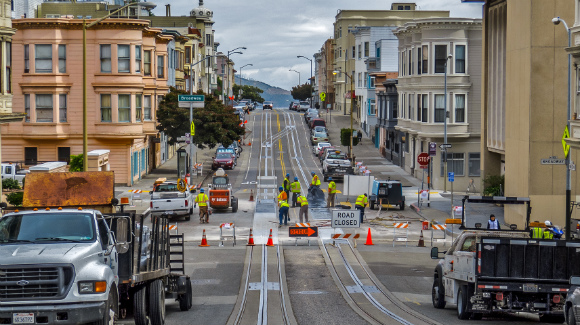
Construction on Broadway Street in San Francisco, CA. (Photo Credit: Daniel Hoherd/Flickr)
With less than a week to go before the budget deadline, the governor and Democrats in the Legislature may still be seeking agreement on a series of big issues—how to spend cap-and-trade revenues, whether to expand access to preschools, and exactly how much to restore social services spending, just to name a few.
But one piece of the governor’s budget continues to avoid major controversy: a proposal supported by the California Economic Summit that would give local governments more authority to invest in infrastructure projects by expanding the authority of an existing financing mechanism known as Infrastructure Financing Districts. The proposal would give local governments financing tools similar to the popular redevelopment agencies disbanded in 2011, which allowed cities to capture a portion of the growth in local property tax revenues and reinvest it in infrastructure and economic development.
“With California’s population only growing, local governments must be able to make needed investments in the state’s infrastructure systems—from water to transportation,” a group of Summit Infrastructure Action Team members wrote in a letter submitted this week to the governor and legislative leaders. “The Summit believes the administration’s ‘Enhanced IFD authority’ is an effective, comprehensive financing tool that will allow the state’s economic regions to remain competitive, and we urge lawmakers to make it a top priority.”
A separate letter from the Southwest MegaRegion Alliance echoed the Summit’s support.
How the budget will support infrastructure investment
While the details are still being negotiated, the final budget is likely to direct a substantial amount of new revenue toward infrastructure. Between the governor’s drought response proposals ($142 million), a sizeable boost in spending on deferred maintenance projects in transportation and other sectors ($815 million), and a bid by the Assembly Speaker to increase investment in affordable housing ($200 million), the state could spend over a billion dollars on closing the state’s massive infrastructure deficit.
The Summit has supported all of these new investments, while pushing state leaders to give local governments more authority to take on their own infrastructure challenges, as well.
The administration’s proposal offers one such tool—and by substantially broadening existing IFD authority, it will allow local agencies to invest in infrastructure projects from affordable housing and transit facilities to sewage treatment and water reclamation.
Thanks to the early engagement of Summit leaders, it will also be a much more substantial financing tool. As the Summit letter points out, the administration made several changes in its May Revision at the Summit’s suggestion that will roughly double the size of the pool of tax increment revenues available to IFDs—bringing the total amount of revenue cities can tap for infrastructure investment to about $400 million a year. Local agencies using IFDs will also have the authority not just to capture property tax revenue growth—but to raise funds through user fees, assessments for benefit, and by leveraging private capital.
“This new tax increment authority may not be as big as redevelopment, but when combined with—and used to leverage—the additional financing provisions outlined below, the funding potential could be far greater,” Summit leaders put it in their letter this week.
The letter highlights four ways the Summit helped strengthen the tools available for local investment in infrastructure:
- Enhanced financing tools: Because property tax increment alone won’t create a pool of resources large enough to meet communities’ needs, the administration’s proposal not only includes the growth of the property tax of participating agencies, it also expands local financing authority beyond just property tax increment—including user fees and assessments for benefit.
- Appropriate project authority: In light of the ongoing drought, the Summit has encouraged the Administration to expand the Enhanced IFD authority to include water management systems like runoff and groundwater recharge. This will make IFDs a useful tool for communities impacted by water shortages that are eager to invest in water projects.
- Increased transparency: In a positive step toward transparency, the administration’s proposal requires IFDs to report on their progress every two years by conducting a performance audit.
- Added flexibility: Enhanced IFDs will also have more flexibility to make infrastructure investments across jurisdictions through the use of Joint Power Authority arrangements.
While higher-profile items may continue to grab budget-related headlines, the governor’s IFD proposal is also deserving of the Legislature’s support. It may not be the only solution for solving California’s infrastructure challenges, but for California’s regional economies, it is an important first step.

